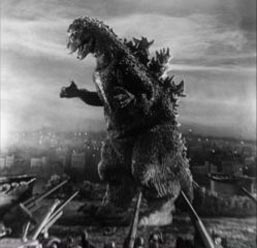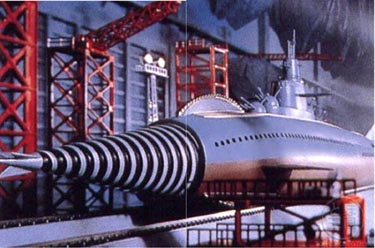|
|
|
|
|
|
|
You like it or not, Eiji Tsuburaya too deserves a little place in special
effects history. Although he did not invent anything new in special effects techinques (and, we could say, he was rather outdated comparing with his western collegues), he gave his contribute to a totally new genre. In a nutshell, Tsuburaya is, together with director Inoshiro Honda, the father of monster Godzilla (in Japanese, Gojira) and all japanese monsters which followed. Effects were really cheap (Godzilla was simply a figurant wearing a rubber costume), and stories were rather inconsistent: anyway, Godzilla in Japan has become a real myth, and anybody who never saw at least a movie starring the giant radioactive lizard please stand up. At his death, Tsuburaya’s work has been continued by his son Hajime. Ending of this chapter, shame on the responsibles of Roland Emmerich remake’s visual effects: helped by the most updated technology, they did not worry about totally erasing Tsuburaya’s work and making a some way more realistic creature but totally different from the original, and neither the typical Godzilla’scream was saved |
|
|
from the crime. The “real” Godzilla absolutely remains a japanese product. Filmography 1954: Gojira (Godzilla) 1956: Sora no daikaiju Radon (Rodan! The flying monster) 1957: Chikyu Boeigun (The Mysterians) 1958: Bijo to eikitainingen (The H-man) 1959: Uchu daisenso (Battle in outer space) 1961: Mosura (Mothra) 1962: King Kong tai Gojira (King Kong versus Godzilla) 1963: Matango (Attack of the mushroom people) 1963: Kaitei gunkan (Atragon) |
 |
|
1964: San daikaiju: Chikyu saidai no kessen (Monster of monsters: Ghidorah) 1965: Furankenshutain tai chitei kaiju Baragon (Frankenstein conquers the world) 1965: Kaiju daisenso (Monster Zero) 1966: Gojira, Ebirah, Mosura: nankai no daiketto (Godzilla versus the sea monster) 1967: Kingu Kongu no gyakushu (King Kong escapes) 1967: Kaijuto no kessen: Gojira no musuko (Son of Godzilla) 1968: Ido zero daisakusen (Latitude zero) |
 |
 |
|